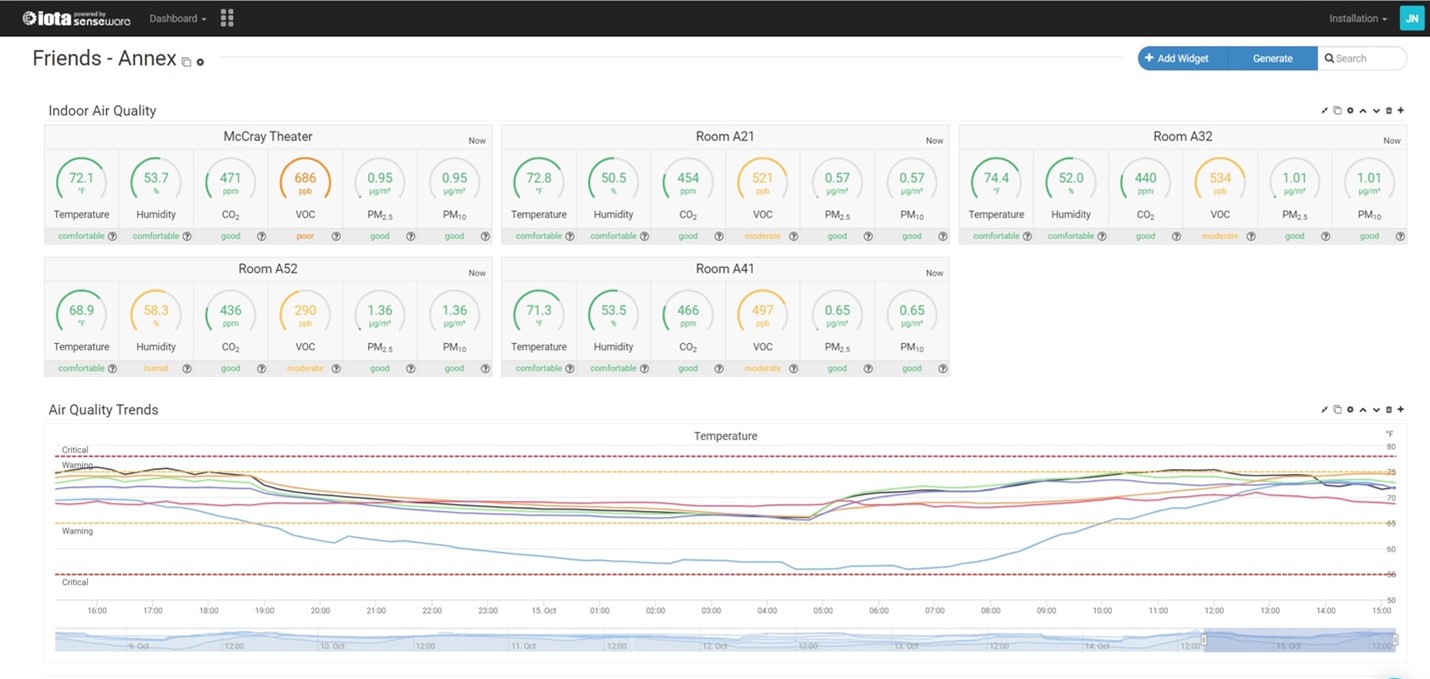By Larry Eighmy, The Stone House Group, and Sisi Kamal, Friends Seminary
After pivoting to remote learning this spring, many schools across the country were eager to find ways to return safely to the classroom this fall. A variety of strategies and techniques have been deployed to mitigate risk, including mask requirements, health screenings, room capacity limitations and physical distancing, as well as HVAC adjustments to increase outdoor air and limit recirculation of potentially contaminated air indoors. In an effort to return as much normalcy as possible, Friends Seminary, a K-12 day school in Manhattan, employed all these techniques with success. But beyond managing the pandemic, the school has plans to continue monitoring a number of indicators, including carbon dioxide and particulate matter concentrations, to track student and staff wellness for years to come.
Like many schools, Friends Seminary began reopening efforts by developing cohort scheduling, rethinking room configurations to de-densify campus and maintain physical distancing, and preparing for daily cleaning and screening procedures.
Cleaner Air
Like many schools, Friends Seminary began reopening efforts by developing cohort scheduling, rethinking room configurations to de-densify campus and maintain physical distancing, and preparing for daily cleaning and screening procedures. The COVID response team soon realized, however, that to mitigate transmission they also needed to address indoor air quality through HVAC operations.
In helping Friends Seminary meet their goals, The Stone House Group ensured the facilities maximized ventilation through dilution and filtration of air, and monitored the effectiveness through a partnership with Iota Communications and use of their indoor air quality sensors and data aggregation and analysis platform.
Dilution
Dilution either by mechanical ventilation through HVAC systems or passive ventilation through open windows brought more fresh, outdoor air into spaces. As for mechanical systems, adjusting outdoor air dampers either physically or through the Building Automation System (BAS) to the widest they could open drew in more outdoor air and diluted air within spaces. Systems were scheduled to turned on two hours prior to the school day and ran for two hours after each day ended to “flush” rooms with fresh air. For rooms that did not have central HVAC systems and relied on open windows and window air conditioners, teachers were instructed to keep windows open all day, turn on window air conditioners, and run newly installed window fans to help circulate a higher volume of outdoor air.
Filtration
The other goal for maximizing ventilation, better filtration, was achieved through superior filtration in the mechanical HVAC unit. For Friends Seminary, this meant using the highest rated filters — swapping out MERV-8 filters for MERV-13 filters. For MERV (minimum efficiency reporting value) filters, the higher the number filter, the finer particles it can capture. Friends Seminary did not use HEPA filters, the filter with the highest rated ability to capture free-floating virus particles, for two reasons: They do not fit in most typical HVAC filter racks, and most school HVAC systems are not powerful enough to move the required amount of air through a HEPA filter and into the indoor space.
Friends Seminary did choose to deploy stand-alone air purifiers with HEPA filters in their two isolation rooms as a precautionary measure to further mitigate exposure risk since the likelihood of airborne COVID-19 particles was higher and potentially more concentrated in these rooms. The central HVAC system continued to supply air to each space, but exhaust air, cleaned through the HEPA filter, was exhausted directly outside and not recirculated into the building-wide HVAC system.
Spaces without central HVAC system, in this case, rooms with window air conditioning units, did not use MERV-13 filters because air was not being recirculated back into the space through a mechanical system multiple times. Additionally, MERV-13 filters are not typically designed for window air conditioning units since window units primarily draw fresh air from outside to cool a space.
Monitoring Key Wellness Indicators
In order to ensure proper ventilation continued across campus after initial operational adjustments, Friends Seminary monitored spaces either through the school’s BAS, which connected to the newer, centrally controlled spaces, or through IotaComm’s portable indoor air quality sensors, which were deployed in classrooms and offices without central HVAC systems or not connected to the BAS.
The indoor air quality sensors monitor room temperature, humidity, CO2 concentration and particulate matter (PM) concentration, among other metrics. All data led into IotaComm’s user friendly web-based dashboard.

CO2 Concentration
Friends Seminary tracked CO2 concentrations to monitor proper room ventilation. If a room’s CO2 concentration approached 1,000 ppm (parts per million), the system sent a warning alert, and if the concentration exceeded 1,500 ppm, it sent a critical alert. Protocols for checking on room ventilation following alerts included verifying that windows were opened and air conditioners/fans were turned on and working as well as close monitoring of the central dashboard for one to two hours to confirm that the CO2 concentration was dropping. If the concentration did not drop, the school would take further measures — open more windows, install more fans or potentially vacate the room for several hours.
Room Temperature and Humidity
From a virus transmission standpoint, high temperatures and high humidity have not been shown to increase the likelihood of transmission, but from an occupant comfort perspective, these high metrics are not conducive for learning.
The indoor air quality sensors also closely monitored room temperature and humidity to verify thermal comfort was appropriate for the learning environment. When school opened in September, it was still quite warm and on some days, some classroom temperatures approached 78-80 degrees Fahrenheit and humidity exceeded 60%. From a virus transmission standpoint, high temperatures and high humidity have not been shown to increase the likelihood of transmission, but from an occupant comfort perspective, these high metrics are not conducive for learning. As temperatures cooled off into the fall, real-time room temperature readings were also helpful for identifying any rooms that could be at risk for freezing pipes overnight if windows were left open, or that needed additional heat during the day to keep occupants warm.
Particulate Matter Concentrations
Monitoring particulate matter concentrations provided insight into both virus transmission as well as occupant health and wellness. In rooms with central HVAC systems (i.e. the Library, blue line in the image below), the particulate matter concentrations were consistently and considerably lower than rooms without central HVAC systems (i.e. Room 306, orange line below).

We believe this is due to the filtration component built into the central systems and the use of higher MERV rated filters. For rooms without central HVAC, filtration was not a necessary component to COVID-19 mitigation as long as dilution was increased, and therefore unfiltered outdoor air circulated in those rooms. Even though outdoor air is “fresh” and still highly preferable to stale — and especially recirculated indoor air — outdoor air still contains particulates such as dust, pollen and other allergens that are not ideal to breathe. Monitoring different types of spaces and comparing data on occupant health and wellness reveal opportunities to make more informed maintenance and programming decisions. The data may suggest when building renovations are scheduled, investment in central HVAC systems will be worthwhile.
The Future of Health and Wellness in Schools
Indoor air quality sensors have been effective in monitoring ventilation as it pertains to COVID-19 transmission mitigation — teachers at Friends Seminary were curious and ecstatic to learn school spaces were going to be monitored. And beyond that, the collected data has begun to inform us about other health and wellness areas.
Prior to sensor installation, a teacher may have submitted a complaint after several days of warmer classroom temperatures, but perhaps could not provide specific temperature readings or time periods during the day. Now, however, with the portable sensors and central database, this data is consistently recorded and can provide real-time alerts. A facilities staff member can identify warmer classrooms and help proactively open windows or adjust thermostats to lessen the impacts on learning, rather than reacting hours or days later.
The more we understand about building operations through monitoring and verification strategies, such as the use of portable indoor air quality sensors or BAS integrated equipment, the better decisions we can make about our spaces. We at The Stone House Group believe that HVAC performance is a “barometer of stewardship,” and in this new environment, health and wellness will become the driving force behind building improvements. Energy management will remain an integral part of sustainability and stewardship, but as this pandemic has shown, occupant health and wellness now takes priority.
We look forward to ongoing partnerships with schools and technology companies to further develop these operating strategies based on ASHRAE, OSHA, CDC and EPA’s recommendations and guidelines regarding dilution, filtration and schedule modifications that will support the health and wellness of students, faculty and staff.
Larry Eighmy is the managing principal at The Stone House Group, which facilitates “building stewardship.” Sisi Kamal is the Chief Financial and Operations Officer at Friends Seminary, a K-12 day school in Manhattan.



